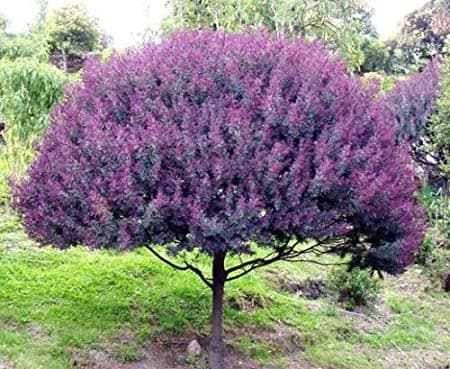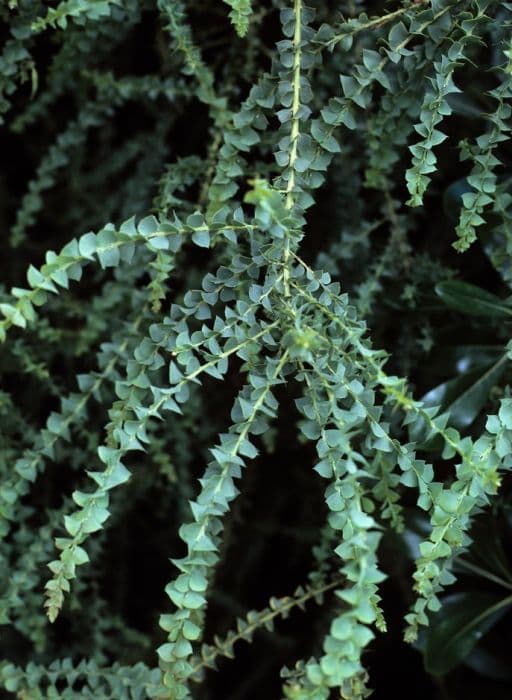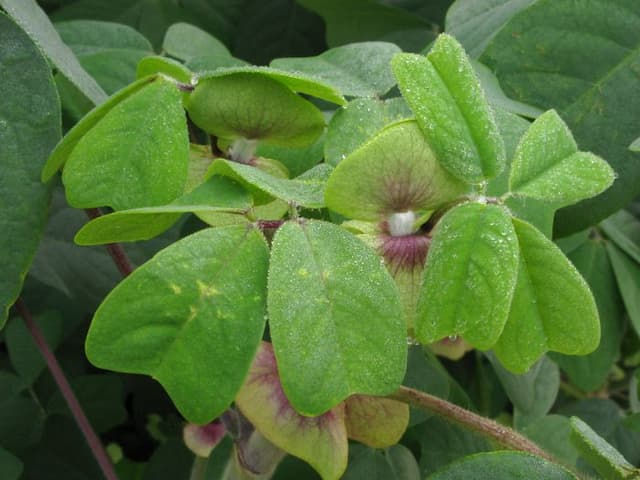Sweet pea Lathyrus odoratus 'Tranquillity'

ABOUT
Lathyrus odoratus 'Tranquillity', commonly known as the sweet pea, is a popular ornamental plant that boasts a charming aesthetic. It is characterized by its delicate tendrils and vibrant flowers. The blooms have a soft, creamy-white hue, and each petal is intricately veined in a subtle fashion, giving them an almost translucent quality. These flowers exude a delightful fragrance that is reminiscent of springtime gardens and mild, pleasant days. The leaves of Tranquillity sweet pea are bright green, adding to the plant's overall refreshment to the senses. They are compound in formation; each leaf consists of multiple smaller leaflets, which are narrow and pointed, providing a feathery backdrop to the dainty flowers. The stems are slender and somewhat wiry, enabling the plant to climb or trail if supported appropriately. Overall, the Tranquillity sweet pea is a feast for the eyes and nose due to its color and scent, and it embodies the essence of a traditional cottage garden plant with its whimsical structure and pastel-toned flowers. Whether used as a cut flower or enjoyed in the garden, it brings an air of calm and beauty to its surroundings.
About this plant
 Names
NamesSynonyms
Sweet Pea, Everlasting Pea, Perennial Pea, Sweetpea.
Common names
Lathyrus odoratus.
 Toxicity
ToxicityTo humans
Sweet pea (Lathyrus odoratus 'Tranquillity') is considered mildly toxic to humans if ingested. The seeds and seed pods are especially harmful and contain a compound called aminopropionitrile that can cause a condition known as lathyrism if consumed in large quantities. Lathyrism is characterized by symptoms such as muscle weakness, paralysis, and potentially permanent damage to the nervous system. The toxicity can vary based on the amount consumed and the individual's sensitivity.
To pets
Sweet pea (Lathyrus odoratus 'Tranquillity') is also toxic to pets, including dogs and cats. The seeds and seed pods contain aminopropionitrile, and ingestion of these parts can lead to lathyrism, which is characterized by vomiting, convulsions, and potentially fatal neurological effects such as muscle weakness and paralysis. If a pet consumes any part of the sweet pea plant, it is crucial to seek veterinary attention promptly.
 Characteristics
CharacteristicsLife cycle
Annuals
Foliage type
Deciduous
Color of leaves
Green
Flower color
White
Height
6 feet (1.83 meters)
Spread
1 foot (0.3 meters)
Plant type
Climber
Hardiness zones
2
Native area
Mediterranean
Benefits
 General Benefits
General Benefits- Ornamental Appeal: Lathyrus odoratus 'Tranquillity', commonly known as Sweet Pea, features delicate flowers that provide aesthetic charm to gardens and landscapes.
- Fragrance: The sweet and alluring scent of Sweet Pea flowers adds a pleasant aroma to garden spaces and cut flower arrangements.
- Variety of Colors: Sweet Peas come in a wide range of colors, allowing for colorful and diverse planting schemes.
- Vertical Interest: Sweet Peas are climbers, perfect for creating height in garden designs by training them up trellises, fences, and obelisks.
- Attracts Pollinators: The flowers of Sweet Peas attract bees, butterflies, and other beneficial insects, supporting pollination in the garden.
- Cut Flowers: Sweet Peas make excellent cut flowers for indoor decoration with their long stems and vibrant blooms.
- Seasonal Cover: They can provide quick seasonal cover for unsightly areas or structures in the garden.
- Easy to Grow: Sweet Peas are generally easy to cultivate, making them a good choice for novice gardeners.
- Edible Uses: Although not related to the edible pea, some sweet peas are grown for their edible shoots in some culinary practices.
- Companion Planting: Sweet Peas can be used effectively in companion planting to assist in the growth of other plants and vegetables.
 Medical Properties
Medical PropertiesThis plant is not used for medical purposes.
 Air-purifying Qualities
Air-purifying QualitiesThis plant is not specifically known for air purifying qualities.
 Other Uses
Other Uses- Lathyrus odoratus 'Tranquillity', also known as sweet pea, can be used in cut flower arrangements due to their long stems and fragrant blooms which can add both visual and olfactory appeal to bouquets.
- In artisanal crafts, dried sweet pea flowers can be incorporated into potpourri mixes to provide a natural and delicate fragrance to a room.
- Sweet pea flowers can serve as natural dye sources, with petals potentially offering hues for textiles and art projects.
- Edible varieties of sweet peas can be used in culinary decorations, though 'Tranquillity' is not edible and should not be consumed.
- Gardening with sweet peas like 'Tranquillity' can be used as a therapeutic activity, providing a calming environment and promoting mental well-being.
- In photography, the vivid colors and attractive form of sweet pea flowers make them excellent subjects for botanical photography and art.
- Sweet peas can play a role in educational gardens and programs, illustrating plant growth, pollination, and climbing plant habits for students and enthusiasts.
- The twining tendrils of sweet peas can be used as a natural support for other plants in the garden, helping to create an integrated planting scheme.
- During festive seasons, sweet pea flowers can be used to create natural decorations, such as wreaths or table centerpieces, bringing a touch of the garden indoors.
- Finally, sweet pea seed pods can be used in dried arrangements or as part of ecological art projects, emphasizing sustainability and the beauty of natural forms.
Interesting Facts
 Feng Shui
Feng ShuiSweet pea is not used in Feng Shui practice.
 Zodiac Sign Compitability
Zodiac Sign CompitabilitySweet pea is not used in astrology practice.
 Plant Symbolism
Plant Symbolism- Blissful Pleasure: Sweet pea is known for its delightful fragrance, symbolizing the pleasurable senses and often associated with fond memories and joy.
- Goodbye: In the language of flowers, sweet pea can signify departure or a wish for a fond farewell, making it appropriate for goodbyes or the end of an era.
- Delicate or Blissful Pleasure: The sweet pea can also represent delicate or blissful pleasure, embodying the gentle and enjoyable moments in life.
- Thank You for a Lovely Time: Often used to express gratitude for a shared special moment or event, sweet pea carries the message of appreciation and acknowledgment.
- Lasting Pleasure: Its long-lasting blooms can be a symbol of lasting pleasure, suggesting a wish for happiness to continue over time.
- Kind Departures: With its association with farewells, sweet pea can also suggest kind departures, offering a sense of goodwill and positivity as someone leaves.
 Water
WaterSweet peas need consistent moisture, so water them regularly to keep the soil evenly moist but not waterlogged. Generally, watering once a week with about 1 inch of water is adequate, but this may need to be increased to twice per week during hot, dry periods. Avoid overhead watering to prevent disease; instead, water at the base of the plants. It's best to use a soaker hose or a dripping system to target the roots directly. During flowering, sweet peas may require additional water, so monitor the soil and adjust accordingly.
 Light
LightSweet peas thrive in full sun, meaning they require at least six hours of direct sunlight daily for optimal growth and blooming. Plant them in a spot where they are exposed to the morning sun, which is less harsh than the afternoon sun, and will still provide the light needed for vigorous growth and vibrant flowers. Avoid overly shaded areas which can lead to weak stems and fewer blooms.
 Temperature
TemperatureSweet peas prefer cooler temperatures and will flourish in conditions between 55°F and 65°F. They can tolerate temperatures as low as 25°F for short periods once established, but growth and flowering are inhibited by heat above 80°F. To prolong the blooming period, plant sweet peas where they can enjoy the warmth of the sun in the spring and then be protected from the intense heat as the season progresses.
 Pruning
PruningPrune sweet peas to encourage bushier growth and more blooms. Pinch off the tips of the plants when they are about 4 to 6 inches tall. As the season progresses, deadhead regularly to promote continuous flowering. The best time to prune sweet peas is in the late winter or early spring before they start their rapid growth, although pinching and deadheading should be done throughout the growing season.
 Cleaning
CleaningAs needed
 Soil
SoilSweet peas thrive in rich, well-drained soil with a pH range between 6.0 and 7.0. A balanced soil mix should incorporate compost or well-rotted manure to improve fertility and structure, and sharp sand or perlite to enhance drainage. Adding bone meal can promote strong root development.
 Repotting
RepottingSweet peas, such as 'Tranquillity', are usually sown directly into the ground or in containers that are large enough to support their growth, so repotting is not frequently required. However, if started in small pots, they should be transplanted before the roots become pot-bound.
 Humidity & Misting
Humidity & MistingSweet peas prefer moderate humidity conditions; it's best if the humidity level ranges from 40% to 60%. Protect them from overly dry air, which can hinder blooming and lead to pest problems.
 Suitable locations
Suitable locationsIndoor
Ensure bright light, cool temps, and good air flow.
Outdoor
Plant in full sun, protect from strong winds, support with trellis.
Hardiness zone
2-11 USDA
 Life cycle
Life cycleThe plant Lathyrus odoratus 'Tranquillity', commonly known as Sweet Pea 'Tranquillity', begins its life as a seed, where with sufficient moisture and warmth, it germinates to produce a small seedling. The seedling, with its embryonic leaves, then develops true leaves and begins to photosynthesize, growing into a young plant. As it matures, it will develop a climbing habit, needing support to grow upwards. The plant continue to grow and eventually produces distinctive, fragrant flowers, which are key to its ornamental appeal. After pollination, typically by bees and other insects, these flowers develop into seed pods, which mature and eventually release seeds, completing the reproductive cycle. Finally, the plant will senesce and die, typically after one season as Sweet Peas 'Tranquillity' are annuals, meaning they complete their life cycle from germination to seed production within one year.
 Propogation
PropogationPropogation time
Early Spring
The most popular method for propagating Sweet Peas, specifically the Lathyrus odoratus 'Tranquillity' variety, is by sowing seeds directly into the soil. This is ideally done in late winter or early spring, depending on the climate. Seeds should be soaked in water for 24 hours to soften the hard outer coating, which can enhance germination rates. Following the soak, plant the seeds about 1 inch deep (approximately 2.5 cm) into well-draining soil in a sunny location. Seedlings usually emerge in 10 to 21 days, and it is important to provide support for the climbing vines as they grow. This method leverages the plant's natural life cycle and is favored for its simplicity and effectiveness.









